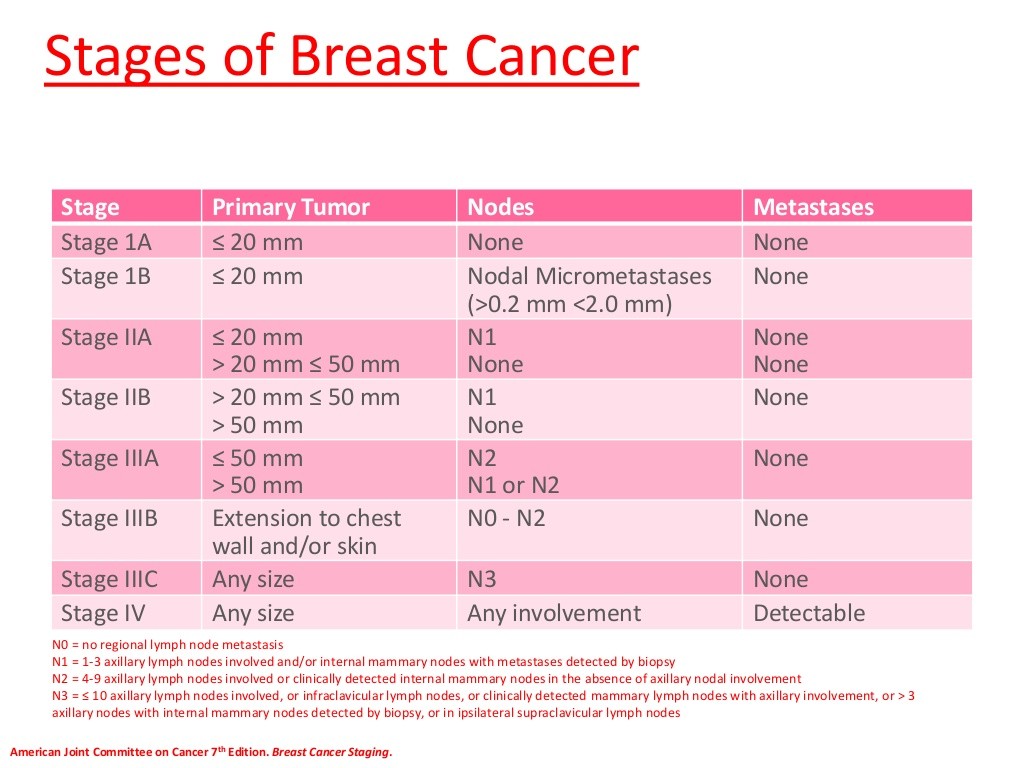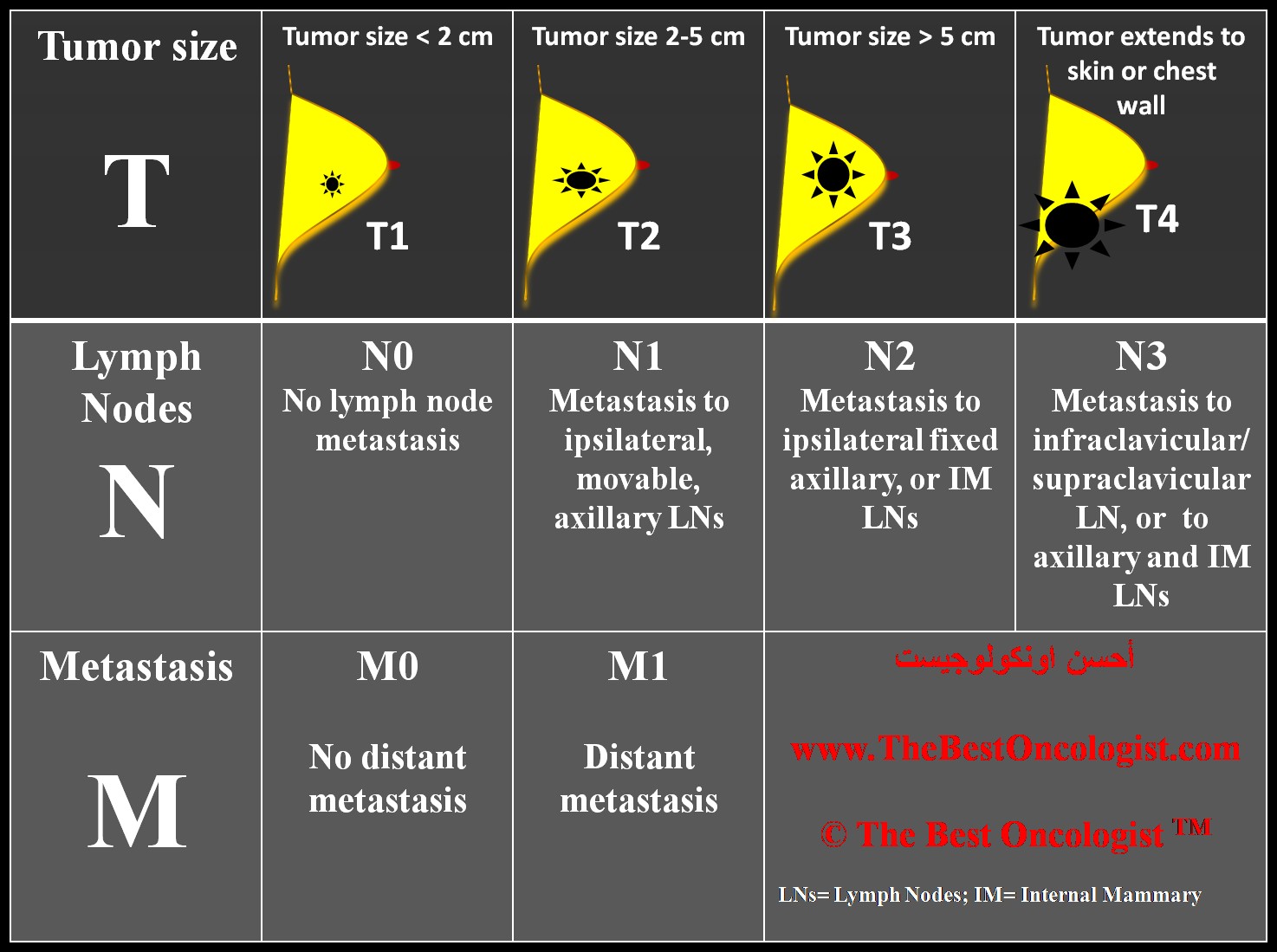Staging of Cancer Breast
Stages of Cancer Breast
Stage 0
Stage I
Stage II
Stage III
Stage IV
Stage I
Stage I describes invasive breast cancer (cancer cells are breaking through to or invading normal surrounding breast tissue)
Stage I is divided into subcategories known as IA and IB.
Stage IA describes invasive breast cancer in which:
the tumor measures up to 2 centimeters AND
the cancer has not spread outside the breast;
No lymph nodes are involved
Stage IB describes invasive breast cancer in which:
There is no tumor in the breast; instead, small groups of cancer cells – larger than 0.2 millimeter but not larger than 2 millimeters – are found in the lymph nodes
OR
There is a tumor in the breast that is no larger than 2 centimeters, and there are small groups of cancer cells – larger than 0.2 millimeter but not larger than 2 millimeters – in the lymph nodes
Microscopic invasion is possible in stage I breast cancer. In microscopic invasion, the cancer cells have just started to invade the tissue outside the lining of the duct or lobule, but the invading cancer cells can't measure more than 1 millimeter.
Stage II
Stage II is divided into subcategories known as IIA and IIB.
Stage IIA describes invasive breast cancer in which:
No tumor can be found in the breast, but cancer (larger than 2 millimeters) is found in 1 to 3 axillary lymph nodes (the lymph nodes under the arm) or in the lymph nodes near the breast bone (found during a sentinel node biopsy)
OR
The tumor measures 2 centimeters or smaller and has spread to the axillary lymph nodes
OR
The tumor is larger than 2 centimeters but not larger than 5 centimeters and has not spread to the axillary lymph nodes
Stage IIB describes invasive breast cancer in which:
The tumor is larger than 2 centimeters but no larger than 5 centimeters;
Small groups of breast cancer cells -- larger than 0.2 millimeter but not larger than 2 millimeters -- are found in the lymph nodes
OR
the tumor is larger than 2 centimeters but no larger than 5 centimeters;
Cancer has spread to 1 to 3 axillary lymph nodes or to lymph nodes near the breastbone (found during a sentinel node biopsy)
OR
The tumor is larger than 5 centimeters but has not spread to the axillary lymph nodes
Stage III
Stage III is divided into subcategories known as IIIA, IIIB, and IIIC.
Stage IIIA describes invasive breast cancer in which either:
No tumor is found in the breast or the tumor may be any size;
Cancer is found in 4 to 9 axillary lymph nodes or in the lymph nodes near the breastbone
OR
The tumor is larger than 5 centimeters;
Small groups of breast cancer cells (larger than 0.2 millimeter but not larger than 2 millimeters) are found in the lymph nodes
OR
The tumor is larger than 5 centimeters;
Cancer has spread to 1 to 3 axillary lymph nodes or to the lymph nodes near the breastbone
Stage IIIB describes invasive breast cancer in which:
The tumor may be any size and has spread to the chest wall and/or skin of the breast and caused swelling or an ulcer
AND
May have spread to up to 9 axillary lymph nodes
OR
May have spread to lymph nodes near the breastbone
Inflammatory breast cancer is considered at least stage IIIB. Typical features of inflammatory breast cancer include:
Reddening of a large portion of the breast skin
The breast feels warm and may be swollen
Cancer cells have spread to the lymph nodes and may be found in the skin
Stage IIIC describes invasive breast cancer in which:
There may be no sign of cancer in the breast or, if there is a tumor, it may be any size and may have spread to the chest wall and/or the skin of the breast
AND
The cancer has spread to 10 or more axillary lymph nodes
OR
The cancer has spread to lymph nodes above or below the collarbone
OR
The cancer has spread to axillary lymph nodes or to lymph nodes near the breastbone
Stage IV
Stage IV describes invasive breast cancer that has spread beyond the breast and nearby lymph nodes to other organs of the body, such as the lungs, distant lymph nodes, skin, bones, liver, or brain.
IV breast cancer:- “advanced” and “metastatic”
Cancer may be stage IV at first diagnosis or it can be a recurrence of a previous breast cancer that has spread to other parts of the body.
TNM Classification
TNM (Tumor, Node, Metastasis)
Sometimes clinical trials require TNM information from participants.
The TNM system is based on three characteristics:
Size (T stands for tumor)
Lymph node involvement (N stands for node)
Metastasized (M stands for metastasis), or moved beyond the breast to other parts of the body.
The T (size) category describes the original (primary) tumor:
TX means the tumor can't be measured or found.
T0 means there isn't any evidence of the primary tumor.
Tis means the cancer is "in situ" (the tumor has not started growing into healthy breast tissue).
T1, T2, T3, T4: These numbers are based on the size of the tumor and the extent to which it has grown into neighboring breast tissue. The higher the T number, the larger the tumor and/or the more it may have grown into the breast tissue.
The N (lymph node involvement) category describes whether or not the cancer has reached nearby lymph nodes:
NX means the nearby lymph nodes can't be measured or found.
N0 means nearby lymph nodes do not contain cancer.
N1, N2, N3: These numbers are based on the number of lymph nodes involved and how much cancer is found in them. The higher the N number, the greater the extent of the lymph node involvement.
The M (metastasis) category tells whether or not there is evidence that the cancer has traveled to other parts of the body:
MX means metastasis can't be measured or found.
M0 means there is no distant metastasis.
M1 means that distant metastasis is present.
Assign a stage to the cancer. For example, a T1 N0 M0 breast cancer would mean that
The primary breast tumor is less than 2 centimeters across (T1),
Has not involved the lymph nodes (N0),
Has not spread to distant parts of the body (M0).
This cancer would be grouped as stage I.




